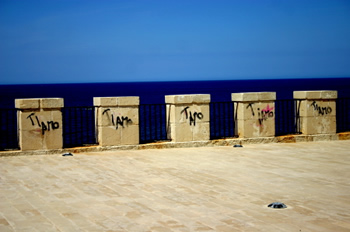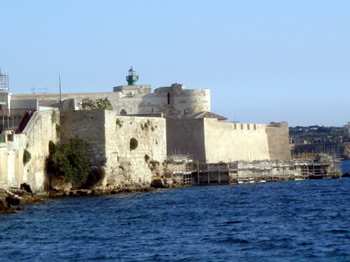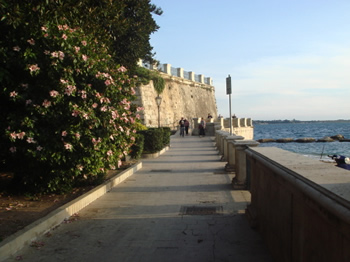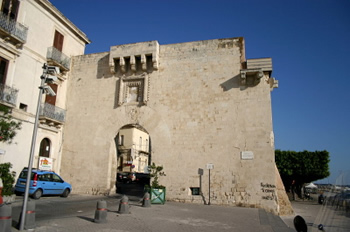
The Seaside of Ortigia, in Syracuse
For those who would like to take a relaxing stroll in Syracuse, the street that runs around the island of Ortigia proves to be ideal, given its modest length, which allows for a complete tour without excessive effort or investment in time.
The Algilà Ortigia Charme Hotel is situated right on the sea; the proposed itinerary goes from the hotel to the tip of the island and back.
Leaving the hotel to the left one finds the remains of the ramparts of San Giovannello, one of the few points still visible from the high walls that completely surrounded Ortigia. They were constructed during Spanish rule, under Charles V, and largely demolished after the unification of Italy (1860).
From this side of the island, the walk
runs along the open sea. After several meters, the street widens
onto a space that offers a beautiful view, the Belvedere San Giacomo,
a favorite romantic destination in Ortigia.
 |
| Belvedere San Giacomo – Syracuse |
The Maniace
Castle
 |
| The Maniace Castle. |
From this time dates the magnificent room under gothic pilasters, which are of rare grandeur and elegance. It is the only part of the original construction, that at one time covered the entire space of the quadrangle (with the exception of the small courtyard), because in 1704 the explosion of a gunpowder magazine made a wing of Swabian / Spanish construction collapse, never to be reconstructed. A few columns of the part that collapsed are seen today incorporated into the walls of the courtyard.
Finally, under Charles V, the castle was surrounded for a good five meters and fortified with bastions that surround it still today, necessary to resist canon fire.
After the unification of Italy, the building was annexed for many years to the adjacent former barracks (that today houses the University of Syracuse), and its return to public use required restoration work and liberation from modern buildings added in the 19th and 20th centuries.
For information: Tel. (++39) 0931 22255
The bank of the Porto Grande
Having reach the point of the island, one moves in the direction of the mainland, along Via Maniace, which ends at Largo Aretusa.
Here, from the remains of a tall Spanish
rampart, it is possible to admire the Fountain
of Arethusa. Going down (thanks to a ramp accessible
even for people with difficulty getting around) to the level of the seashore,
one arrives at the Villetta Aretusa, a little garden (complete with
public changing rooms) adorned with shady and exotic ficus
trees, under which the entrance to the Aquarium
opens.
 |
| The walkway of the Villetta Aretusa. |
The
port can be visited by boat, which departs not far from the Villetta
Aretusa.
Past the public garden, leaning upon the
base of the wall you can see the so-called Fontana degli Schiavi (Fountain
of the Slaves), decorated in relief and constructed in the Spanish
era as an alternative water supply, after the construction of the ramparts
had made use of the Fountain of Arethusa problematic.
From this point one proceeds along a route suitable for walking since the 19th century, the Foro Italico (Italian Forum), featuring trees, benches, and above all an atmospheric view of the city and of the port, which is particularly picturesque at sunset and at night.
 |
| Porta Marina. |
The gate, which lost its upper part, appears extremely plain; it’s decorated from a gothic-Catalan kiosk, worked with delicate ornamental relief.
A little further along, a detour is warranted to the little church of Santa Maria dei Miracoli (from the 13th century, but reconstructed after its destruction during the Second World War), that retains a beautiful gothic-renaissance façade, with stained glass windows from 1501 of the Madonna and saints.
In front of Porta Marina, from pier Zanàgora in the holiday period (summer), the boats depart for the beaches of Punta del Pero and Isola Maddalena.
To return to the hotel one can make a cut,
reaching corso Matteotti and from here taking via Mirabella, that emerges
right next to the hotel Algilà; otherwise complete the tour of the
island by following the canal that cuts through the isthmus.
This area has a thoroughly modern appearance,
as occupied by buildings made in the space obtained, after the unification
of Italy, by demolishing the mammoth Spanish ramparts that protected access
to the island.
Following the sea, one arrives at the Porto
piccolo (Little Port), reserved for smaller boats.
Located here (at pier Forte Gallo)
is the Yachting
Club of Syracuse, which offers moorings, boat rentals, sailing
courses, and fishing and also organizes tourist visits along the seaside.
From here, along the coast occupied by modern port facilities, one returns to the ramparts of San Giovannello and therefore to the Hotel Agilà.
The Algilà
Ortigia Charme Hotel is situated directly on the sea in the rich
historic center of Syracuse, in an excellent position nearby all of the
most important tourist attractions of Syracuse.
The hotel offers rooms with views of the
sea.
Back to TOURISM IN SYRACUSE, SICILY